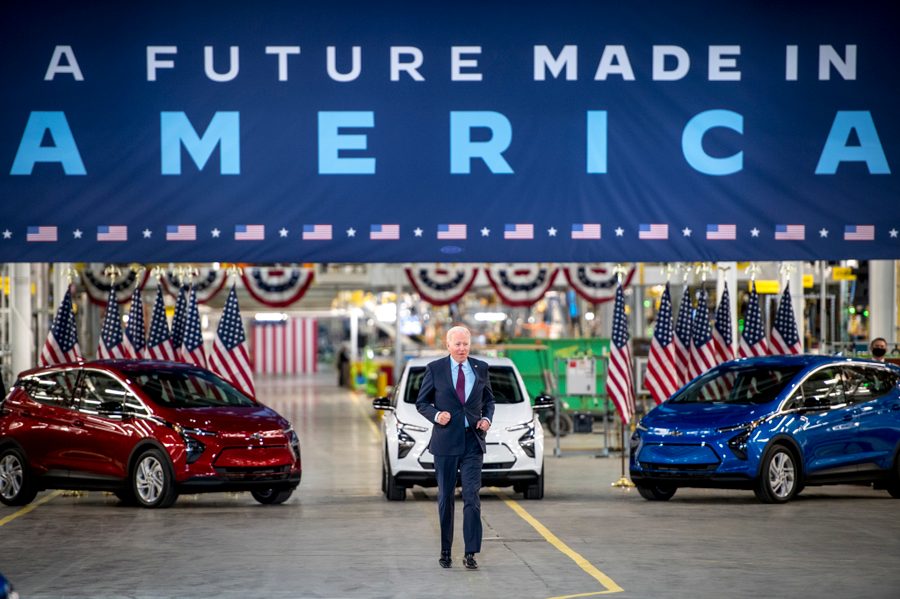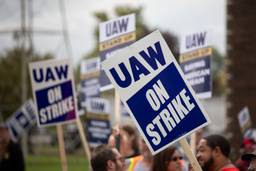How the Government Can Help Build Industrial Unions
Money. For organizing. Give it to us.
Hamilton Nolan

Each passing week seems to bring new reasons for the workers of America to dream big. Hollywood has been shut down for months by twin strikes from the Writers Guild of America and the actors of SAG-AFTRA, and the WGA has now successfully reached a tentative agreement with the haughty coalition of Hollywood studios. At the same time, the United Auto Workers strike against the Big Three automakers continues to expand. Both of these massive labor actions are examples of the power that unions can wield when they control the work force of not just a single company, but a significant part of an entire industry.
On Tuesday, President Joe Biden joined the UAW picket line in Michigan. Now, the labor leaders who have his ear should be pushing him to help the labor movement’s big dreams coalesce. Biden has an industrial policy. And he has a union policy. How about an industrial union policy?
By this I mean: taking Biden’s pro-union bona fides as real, it is common sense for organized labor to push him to activate the levers of government as far as humanly possible to strengthen unions before he is replaced by a surely awful Republican. The highlights of Biden’s first term have been historic public investments in infrastructure and an aggressively pro-labor NLRB that has begun the long task of bending labor law back in a helpful direction. If Biden wins a second term, the labor movement should think about pushing for direct material support for itself in a way that neither it nor the White House seem to have considered so far.
The miserable six percent union density in the private sector means that reasons for unions to think industrially today are pretty scarce. But there are pockets of American business where union density is high enough that you can see the industry-wide effects of union power. Hollywood, Nevada casinos, airlines — these are places where middle class jobs exist only because unions have gained so much power that they can credibly threaten to disrupt an entire industry.
In the case of the UAW, their strike highlights both the promise and peril of industrial density. They have it at the Big Three, and are consequently still able to shut down the heart of the U.S. auto industry when they strike. But the rise of non-union Tesla, the lack of unions in the growing electric vehicle industry overall, and the frequent migration of auto factories to “right to work” Southern states (or to Mexico) are all existential perils to the continuation of that legacy labor power. Like sharks, unions can never sit still. Businesses will always do their utmost to move jobs away from unions. Wherever the jobs go, the unions must organize, fast, or they will die out.
The government has traditionally taken a fairly hands-off approach to this process — at best, they use economic incentives to tempt businesses to be less hostile to unions. But for the most part, the task of keeping up with the movement of jobs is left to organized labor itself. And for the past half century, organized labor has been losing this race to organize by a wide margin, as the union density numbers prove.
While negotiating the Inflation Reduction Act, Democrats tried to attach a hefty tax credit for unionized factories to the huge injection of government money into the industry, but that credit didn’t make it into the final bill. Apart from such credits — which are essentially bribes paid to companies in exchange for not union busting — what can the government do to help a union like UAW, which must unionize tens of thousands of workers in the “right to work” South, and at rich and staunchly anti-union companies like Tesla, if it wants to maintain its power for generations to come?
Well, the most meaningful thing would be abolishing “right to work” laws altogether and creating harsh penalties for unfair corporate union busting tactics — but that would mean passing a transformative bill like the PRO Act, which will likely never get through Congress as long as the filibuster exists. The NLRB can make it marginally easier for unions to organize, but the White House cannot change this basic truth: The UAW will have to find a way to win big, costly, time-intensive union drives at big factories owned by well-capitalized companies in poor “right to work” states where the workers are being squeezed by local politicians and employers alike.
Can such union drives be won? Yes. Moreover, they must be won, or worker power in that industry will go away. Simple. There is a big difference between a hard organizing campaign and an impossible one. (If hard union organizing campaigns were never successful, America would not have any unions.) If we take the hostile political landscape and inevitable union busting as a given, large-scale organizing becomes primarily a question of resources. The UAW must be able to train and pay a lot of good organizers and put them in a lot of places for a long time to build successful campaigns in these conditions.
Having eliminated all of the other options, this is the only choice, other than shrugging and seeing the current UAW strike as the last hurrah of that proud union’s industrial power.
Workers want unions. And in the states with the most anti-labor conditions, workers need unions more than anywhere else. The UAW (and other unions who face the same urgent necessities) desperately need to organize under these conditions. It will take a lot of money. To make a meaningful change, it will require an investment of billions of dollars in union organizing. Spending on this scale is completely reasonable when you consider the size of the task at hand, but no union in America has this much money to spend on what must be done. This is the place where the government — sympathetic to the cause, but hamstrung by political reality — can step in to help.
If the Biden administration has hit its limit on passing labor law reforms or creating tax incentives, it must turn its attention to funding union organizing. I have written before about how this could look—it could take the shape of a grantmaking board run through the Labor Department, for example, or a similar format that would allow unions themselves to determine their targets and priorities and needs, and then get government money to fund the cost.
Unions ask the government for money all the time, but not for organizing costs, and therefore this particular idea has never gained a high profile on labor’s wish list. That is a mistake. No union in America has a treasury big enough to organize at the scale that is necessary to build and maintain the sort of industrial power in today’s world that unions like the WGA and UAW built generations ago. What are the alternatives? Do we give up on the possibility of ever raising union density? Do we continue to bang our heads on the brick wall of passing the PRO Act, as multinational corporations laugh and relocate all their factories to South Carolina? We have to organize. And we need the money.
The first and most important step to making this a reality is for organized labor to ask for it. Tell the Democrats: We need the money to organize. Give us the money. Carve it out of the DOL budget. Attach it to the Defense spending bill. Give unions a casino license. Sell the White House art collection. Do what you need to do. But above all, make Joe Biden cough up something even more important than a friendly trip to the picket line: The salaries of ten thousand new union organizers.
Real friends pick up the check.
Hamilton Nolan is a labor writer for In These Times. He has spent the past decade writing about labor and politics for Gawker, Splinter, The Guardian, and elsewhere. More of his work is on Substack.








